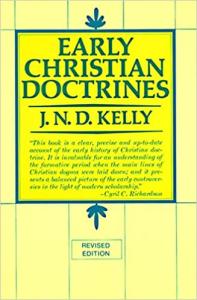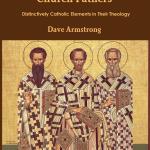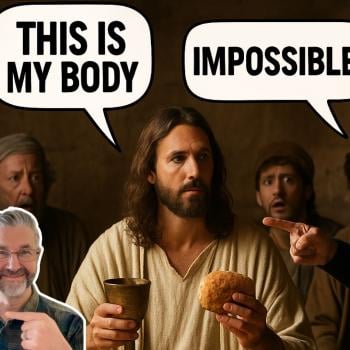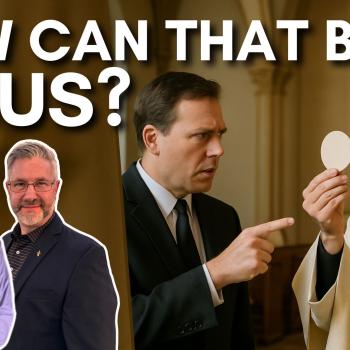Lucas Banzoli is a very active Brazilian anti-Catholic polemicist, who holds to basically a Seventh-Day Adventist theology, whereby there is no such thing as a soul that consciously exists outside of a body, and no hell (soul sleep and annihilationism). This leads him to a Christology which is deficient and heterodox in terms of Christ’s human nature after His death. He has a Master’s degree in theology, a degree and postgraduate work in history, a license in letters, and is a history teacher, author of 25 books, as well as blogmaster (but now inactive) for six blogs. He’s active on YouTube.
This is my 26th refutation of articles written by Lucas Banzoli. As of yet, I haven’t received a single word in reply to any of them (or if Banzoli has replied to anything, anywhere, he certainly hasn’t informed me of it). Readers may decide for themselves why that is the case. His words will be in blue. I use RSV for the Bible passages unless otherwise indicated. Google Translate is utilized to render Lucas’ Portugese into English.
*****
I’m replying to a portion of Lucas’ article, “Os Pais da Igreja e a transubstanciação – Parte 1” [The Church Fathers and Transubstantiation (Part 1)] (8-22-12).
If the substance and nature of the bread were literally transformed into the body of Christ, then Christ would be physically present in a piece of bread(!), which is clearly unfounded. This is why the Church Fathers understood Christ’s statements, that the bread was his body and the wine his blood, figuratively rather than literally. As Tertullian (160 – 220) said: [cites Against Marcion, III, 19]
Tertullian asserted that God called his body “bread”, and then did not suggest that the bread is literally the body of Christ in a physical and material sense, but that it was in a figurative sense, as he says shortly afterwards: “ …that you may understand that he gave the figure of bread to his body”. If it was a figure, then the bread was figuratively the body of Christ, not literally. On another occasion Tertullian reiterated that the bread being a body was a “figure”, and not something to be taken literally: [cites Against Marcion, IV, 40]
In other words, the bread being the body of Christ was “a figuration,” and Christ figured the body in the bread, and did not literally make it the body itself!
Okay; duly noted. Lucas has played the usual polemical anti-Catholic Protestant game of citing a few snippets out of context, with a “wishful thinking” interpretation: trying to desperately, somehow, magically transform a Catholic Church father into a proto-Protestant. Now let’s see what actual (Protestant, not Catholic) patristic scholars think about Tertullian’s eucharistic theology:
In the West the equation of the consecrated elements with the body and blood was quite straightforward . . . Tertullian regularly describes [E.g. de orat. 19; de idol. 7] the bread as ‘the Lord’s body’. The converted pagan, he remarks, [De pud. 9] ‘feeds on the richness of the Lord’s body, that is, on the eucharist’. The realism of his theology comes to light in the argument, [De res. carn. 8] . . . that . . . in the eucharist ‘the flesh feeds on Christ’s body and blood so that the soul may be filled with God’. (Early Christian Doctrines, San Francisco: Harper & Row, 1978 edition, pp. 210-211)
Occasionally these writers use language which has been held to imply that, for all its realist sound, their use of the terms ‘body’ and ‘blood’ may after all be merely symbolical. Tertullian, for example, refers [E.g. C. Marc. 3, 19; 4, 40] to the bread as ‘a figure’ (figura) of Christ’s body, and once speaks [Ibid I, 14: cf. Hippolytus, apost. trad. 32, 3] of ‘the bread by which He represents (repraesentat) His very body.’ Yet we should be cautious about interpreting such expressions in a modern fashion. According to ancient modes of thought a mysterious relationship existed between the thing symbolized and its symbol, figure or type; the symbol in some sense was the thing symbolized. Again, the verb repraesentare, in Tertullian’s vocabulary [Cf. ibid 4, 22; de monog. 10], retained its original significance of ‘to make present.’ All that his language really suggests is that, while accepting the equation of the elements with the body and blood, he remains conscious of the sacramental distinction between them. In fact, he is trying, with the aid of the concept of figura, to rationalize to himself the apparent contradiction between (a) the dogma that the elements are now Christ’s body and blood, and (b) the empirical fact that for sensation they remain bread and wine. (Ibid., 212)
Tertullian defines [De virg. vel. 9] the priestly function as one of ‘offering’ (offerre); the ‘offering of the sacrifice’ [De cult. fem. 2, 11] . . . (Ibid., p. 214)
The word he [St. Ambrose] employs (transfiguratur), as Tertullian had pointed out [C. Prax. 27, 7] long before, connotes the actual change of something from what it previously was to a fresh mode of being. (Ibid., p. 446)
During this period, as we might expect, the eucharist was regarded without question as the Christian sacrifice. (Ibid., p. 449)
Philip Schaff observed in his History of the Christian Church, Vol. 2 (§ 69. The Doctrine of the Eucharist):
Tertullian must not be understood as teaching a merely symbolical presence of Christ; for in other places he speaks, according to his general realistic turn, in almost materialistic language of an eating of the body of Christ, and extends the participation even to the body of the receiver.
[Footnote: De Resur. Carnis, c. 8.”Caro corpore et sanguine Christi vescitur, ut et anima de Deo saginetur.” De Pudic. c. 9, he refers the fatted calf, in the parable of the prodigal son, to the Lord’s Supper, and says: “Opimitate Dominici corporis vescitur, eucharistia scilicet.” De Orat. c. 6: “Quod et corpus Christi in pane censetur,” which should probably be translated: is to be understood by the bread (not contained in the bread).]
***
Practical Matters: Perhaps some of my 4,000+ free online articles (the most comprehensive “one-stop” Catholic apologetics site) or fifty books have helped you (by God’s grace) to decide to become Catholic or to return to the Church, or better understand some doctrines and why we believe them.
Or you may believe my work is worthy to support for the purpose of apologetics and evangelism in general. If so, please seriously consider a much-needed financial contribution. I’m always in need of more funds: especially monthly support. “The laborer is worthy of his wages” (1 Tim 5:18, NKJV). 1 December 2021 was my 20th anniversary as a full-time Catholic apologist, and February 2022 marked the 25th anniversary of my blog.
PayPal donations are the easiest: just send to my email address: [email protected]. You’ll see the term “Catholic Used Book Service”, which is my old side-business. To learn about the different methods of contributing, including 100% tax deduction, etc., see my page: About Catholic Apologist Dave Armstrong / Donation Information. Thanks a million from the bottom of my heart!
***
Photo credit: Anglican scholar J.N.D. Kelly’s classic summary of the views of the Church fathers, 1978 edition, from the Amazon book page.
***
Summary: Brazilian Protestant apologist Lucas Banzoli tries to argue that Tertullian believed in a symbolic Eucharist. Anglican patristic scholar J.N.D. Kelly totally disagrees.













